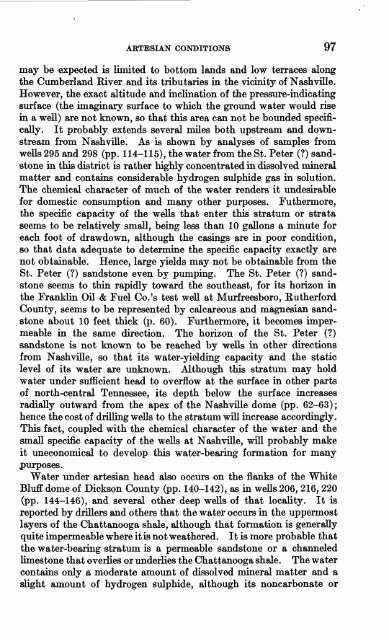GROUND WATER IN NORTH-CENTRAL TENNESSEE
GROUND WATER IN NORTH-CENTRAL TENNESSEE
GROUND WATER IN NORTH-CENTRAL TENNESSEE
You also want an ePaper? Increase the reach of your titles
YUMPU automatically turns print PDFs into web optimized ePapers that Google loves.
ARTESIAN CONDITIONS 97<br />
may be expected is limited to bottom lands and low terraces along<br />
the Cumberland Kiver and its tributaries in the vicinity of Nashville.<br />
However, the exact altitude and inclination of the pressure-indicating<br />
surface (the imaginary surface to which the ground water would rise<br />
in a well) are not known, so that this area can not be bounded specifi<br />
cally. It probably extends several miles both upstream and down<br />
stream from Nashville. As is shown by analyses of samples from<br />
weUs 295 and 298 (pp. 114-115), the water from the St. Peter (?) sand<br />
stone in this district is rather highly concentrated in dissolved mineral<br />
matter and contains considerable hydrogen sulphide gas in solution.<br />
The chemical character of much of the water renders it undesirable<br />
for domestic consumption and many other purposes. Futhermore,<br />
the specific capacity of the wells that enter this stratum or strata<br />
seems to be relatively small, being less than 10 gallons a minute for<br />
each foot of drawdown, although the casings are in poor condition,<br />
so that data adequate to determine the specific capacity exactly are<br />
not obtainable. Hence, large yields may not be obtainable from the<br />
St. Peter (?) sandstone even by pumping. The St. Peter (?) sand<br />
stone seems to thin rapidly toward the southeast, for its horizon in<br />
the Franklin Oil & Fuel Co.'s test well at Murfreesboro, Kutherford<br />
County, seems to be represented by calcareous and magnesian sand<br />
stone about 10 feet thick (p. 60). Furthermore, it becomes imper<br />
meable in the same direction. The horizon of the St. Peter (?)<br />
sandstone is not known to be reached by wells in other directions<br />
from Nashville, so that its water-yielding capacity and the static<br />
level of its water are unknown. Although this stratum may hold<br />
water under sufficient head to overflow at the surface in other parts<br />
of north-central Tennessee, its depth below the surface increases<br />
radially outward from the apex of the Nashville dome (pp. 62-63);<br />
hence the cost of drilling wells to the stratum will increase accordingly.<br />
This fact, coupled with the chemical character of the water and the<br />
small specific capacity of the wells at Nashville, will probably make<br />
it uneconomical to develop this water-bearing formation for many<br />
purposes.<br />
Water under artesian head also occurs on the flanks of the White<br />
Bluff dome of Dickson County (pp. 140-142), as in wells 206, 216, 220<br />
(pp. 144-146), and several other deep wells of that locality. It is<br />
reported by drillers and others that the water occurs in the uppermost<br />
layers of the Chattanooga shale, although that formation is generally<br />
quite impermeable where it is not weathered. It is more probable that<br />
the water-bearing stratum is a permeable sandstone or a channeled<br />
Umestone that overlies or underlies the Chattanooga shale. The water<br />
contains only a moderate amount of dissolved mineral matter and a<br />
slight amount of hydrogen sulphide, although its noncarbonate or

















